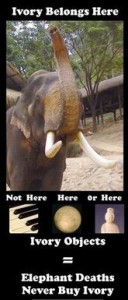Elephant Poaching
 The poaching of elephants for ivory, meat, hide and other parts (mainly for use in traditional medicine) is still prevalent in many countries across Asia. Despite worldwide protection through the Convention
The poaching of elephants for ivory, meat, hide and other parts (mainly for use in traditional medicine) is still prevalent in many countries across Asia. Despite worldwide protection through the Convention
on International Trade in Endangered Species (CITES) Treaty, the value placed on elephant products, particularly ivory, the lack of effective enforcement and the remoteness of areas of elephant habitat means that there are those that still kill elephants for profit.
The Ivory Trade
Elephant ivory has been used by humans since the earliest times. Evidence even exists of early man building simple dwellings from piles of mammoth tusks. Ivory carvings have comprised an important part of Asian art for over a thousand years and demand in the 19th and early part of the 20th century for mundane items as billiard balls and piano keys has led to the slaughter of literally hundreds of thousands of elephants.
It is important to state that Asian elephants are far less prone to poaching than African elephants because only some Asian males have tusks and both sexes are tusk bearing in African elephants. However, among ivory carvers it is said that Asian ivory is of a higher quality. Whether this difference is real or perceived it still exists and therefore creates a demand for Asian elephant tusks.
Although hard reliable data about the extent of poaching is difficult to comes across, not least because of its illegal nature, there is some information and plenty of anecdotal evidence. Studies undertaken by Raman Sukumar in India suggest that ivory poaching was responsible for between 44 and 68% of all male elephant deaths in three Indian provinces. There is also widespread evidence of poaching in other parts of southeast Asia; particularly Cambodia, Vietnam and Laos where alarming decreases in the elephant population seem to have been caused by poaching.
One of the problems associated with poaching male Asian elephants is the creation of serious imbalances in the ration between the sexes. This affects not just the rate of reproduction, but also leads to a decline in the necessary genetic diversity required to ensure healthy populations. This phenomenon is being demonstrated by the growing prevalence of males without tusks as the ‘tusk’ gene is disappearing.
In recent years, organisations such as Traffic are starting to report a decline in demand for ivory as the international public’s awareness of the issue grows. However, there is still enormous demand in both China and Japan for ivory products – particularly netsuke and personal chops.
Poaching for Hide and Meat
Elephant killings for meat alone are rare and usually the result of a chance encounter in the forest. The time and energy required to prepare and transport the meat, as well as reluctance by many populations to countenance the eating of elephant, makes it an uneconomical endeavour.
Elephant hide however does have value and high quality clothes and furnishings of elephant leather are sold in boutiques across Asia.
Poaching for Medicinal Use
The use of exotic animal products in traditional Asian medicine is well known and sadly elephants are no exception. It is known that poachers killing elephants for medicinal products will poison waterholes and track fallen elephants before stripping the carcass.
Poaching for the Entertainment and Other Industries
In some parts of Asia, wild elephants are captured live, trained and put to work. This is a form of poaching that removes elephants from the wild.
Although officially banned, it is known that elephant capture on a significant scale still continues in Burma to provide elephants for the logging industry. EleAid is also aware of the existence of poaching operations designed to capture and deliver elephants, mainly babies, for the tourist elephant camps in Thailand. The elephants are captured in Burma, smuggled over the border and given false registration papers showing the animals to be born in captivity.
Wild elephant capture often results in elephant deaths, particularly if the poachers are trying to capture young elephants. Often the herd will violently turn on the poachers to protect the young which results in them being shot.
Poaching in all its forms is a violent and brutal crime and EleAid supports the rigorous enforcement of anti-poaching legislation and harsh penalties for offenders.


